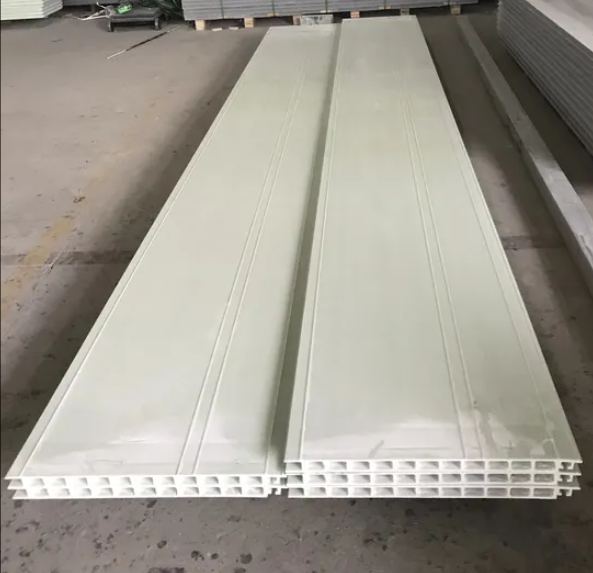Introduction
Sourcing fiberglass deck materials in bulk is a strategic decision that affects structural performance, worker safety, and your project schedule. Whether you’re building chemical‑resistant walkways in a wastewater plant or equipping a coastal pier with non‑conductive grating, choosing where to buy fiberglass deck materials determines how smoothly those goals are met.
One vetted example is Unicomposite, an ISO‑certified pultrusion manufacturer in China that pairs large‑scale production with in‑house engineers who routinely help utilities, civil contractors, and OEMs fine‑tune profile designs. Their operation illustrates what buyers should expect from a modern supplier: traceable quality, customization, and transparent communication.

fiberglass decking panels
Understanding Fiberglass Deck Materials & Market Needs
Key Performance Properties
Fiberglass‑reinforced plastic (FRP) decking owes its popularity to a high strength‑to‑weight ratio (up to 3.3× that of structural steel at equal weight), corrosion resistance even in splash zones, and dielectric strength that makes it safe around live electrical gear.
Global demand mirrors these advantages: the fiberglass market was valued at USD 12.34 billion in 2024 and is forecast to grow 6.7 % annually through 2030.
Typical Industrial & Commercial Applications
Power utilities: non‑conductive platforms inside substations
Wastewater facilities: grating over aeration basins
Agriculture & aquaculture: anti‑slip walkways that withstand manure and salt
OEM equipment: lightweight access ladders and guard rails
Each scenario prioritizes long service life and minimal maintenance, so buyers look beyond upfront price and weigh lifecycle cost.
Evaluating Suppliers — What to Look For
Certifications, Quality Control, and Material Traceability
Request documented compliance with ASTM standards such as D3916 tensile testing and F1092 open‑weather deck specification.
Reputable plants run statistical process control and provide heat‑lot numbers that follow each panel from resin mixing to final cure.
Engineering Support & Customization Capabilities
“The lowest total cost comes from designing profiles for manufacturability at the quotation stage—small tweaks in glass orientation can cut resin consumption 8–10 %,” notes an engineering manager at a U.S. civil contractor.
Suppliers like Unicomposite keep composite engineers on staff, allowing buyers to co‑create shapes, resins, and surface finishes instead of settling for catalog parts. Rapid prototyping shortens qualification cycles and keeps projects on schedule.
Buying Channels — Domestic vs. International
Direct Manufacturer Partnership
Partnering directly with a factory—especially one that owns its pultrusion lines—offers:
Shorter feedback loops on design changes
Lower unit cost once minimum order quantities (MOQs) are met
Visibility into production planning
A Mid‑Atlantic utility that performed a virtual walkthrough of Unicomposite’s facility trimmed lead‑time estimates by 15 %.
Authorized Distributors & Regional Stocking Centers
Distributors add margin but hold local inventory, which can be decisive for shutdown‑critical repairs. They often bundle multiple brands, so verify origin and lot traceability.
Online Marketplaces & Digital Procurement Platforms
E‑procurement sites excel at spot buys and price discovery yet rarely provide engineering support. Use them for commodity shapes, not custom pultrusions.
Cost Factors and Total Cost of Ownership
Resin & Glass Pricing Drivers
Epoxy and polyester resins track crude‑oil derivatives, while e‑glass rovings follow energy and sand prices. A 5 % swing in resin cost can move the finished panel price by 2–3 %.
Logistics, Tariffs, and Lead Times for Bulk Orders
Container freight is volatile: spot rates from Shanghai to the U.S. West Coast averaged USD 5,876 for a 40‑ft container in early June 2025, more than double their April level.
Plan procurement windows around these curves, and compare CIF pricing against FOB + inland trucking to your site.
Lifecycle ROI vs. Traditional Decking
An anonymized hydro plant that swapped galvanized steel for FRP walkway panels reported maintenance savings of USD 180,000 over ten years, driven by eliminated sand‑blasting and repaint cycles.
Due Diligence Checklist Before Placing a Purchase Order
Physical samples & lab tests – verify tensile and water‑absorption results (ASTM D5117, D570).
Factory audits – onsite or 360° video tour; confirm pultrusion line throughput and curing ovens are sufficient for your schedule.
Contract terms – clarify MOQs, tolerance bands, color matching, and after‑sales stocking of replacement panels.
Field trials – install a test bay for at least one weather cycle to validate deflection models.
Conclusion
Selecting where to buy fiberglass deck materials is ultimately a risk‑management exercise. Evaluate technical credentials first, weigh real logistics costs, and insist on tangible proof of long‑term performance. Manufacturers that match Unicomposite’s blend of ISO certification, engineering guidance, and scalable capacity help industrial buyers lock in predictable quality and lower total cost.
Ready to spec your next project? Request a sample kit or a no‑obligation design review today.
Frequently Asked Questions
Q1: How quickly can I receive bulk fiberglass decking after placing an order?
Lead times range from 4 – 10 weeks depending on resin availability and freight capacity. Confirm production slots and shipping lanes during quotation.
Q2: Can FRP decking be tailored to different load ratings?
Yes. By adjusting glass fiber orientation and panel thickness, suppliers can meet uniform load requirements from 100 psf to 300 psf without changing overall footprint.
Q3: Are certifications like ISO 9001 mandatory?
They are not legally required, but ISO‑certified plants provide traceable quality processes, reducing the risk of batch variability.
Q4: How do tariffs affect international purchases?
Tariff rates on FRP profiles can add 15–25 % to landed cost; however, negotiating long‑term contracts during low‑rate windows or shipping to free‑trade zones can offset part of the surcharge.
Q5: What maintenance does fiberglass decking need?
Routine cleaning with mild detergents is typically sufficient; no painting or cathodic protection is necessary, cutting lifecycle labor hours by up to 70 %.
 info@unicomposite.com
info@unicomposite.com


























